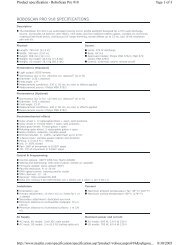Palco 3/5 - Prolight
Palco 3/5 - Prolight
Palco 3/5 - Prolight
Create successful ePaper yourself
Turn your PDF publications into a flip-book with our unique Google optimized e-Paper software.
GB<br />
SGM Elettronica - Light Technology<br />
<strong>Palco</strong> can be panned through + or – 45° and tilted –75° (backwards) and +15° (forwards).<br />
The required movement is fixed by means of the screws on the head support, as shown in the diagram. The hex keys<br />
for fixing PAN and TILT are supplied with the fixture and are (respectively) 6 mm. and 3 mm. keys<br />
Addressing the fixture<br />
<strong>Palco</strong> 3 and <strong>Palco</strong> 5 are fitted with an on-board microcomputer, which enables them to be configured and addressed for<br />
the control of their programming.<br />
There are two fundamental modes in which the units can operate:<br />
Controlled via DMX by an external console<br />
Stand-alone Mode with on-board programming and the possible control of a series of other fixtures using a MASTER-<br />
SLAVE set-up.<br />
We’ll now cover the addressing of a <strong>Palco</strong> for DMX control using an external console. Stand-Alone mode on the other<br />
hand is covered in the “Stand-alone Programming chapter”<br />
Once the fixture is switched on, its name appears in the display (PALCO 3 or PALCO 5) along with the version of the<br />
software installed on the microcomputer (e.g.: 1.0). As soon as the start-up sequence is finished, “ADDR = 1” will<br />
appear on the display, showing that the fixture is addressed to DMX channel 1.<br />
Attention: If the flashing message NO SIGNAL or SIGNAL ERROR appears, this means that the fixture<br />
is not receiving a DMX signal from the Console or is receiving an incorrect signal.<br />
<strong>Palco</strong> 3 - <strong>Palco</strong> 5 - 17 - User's manual 1.01






